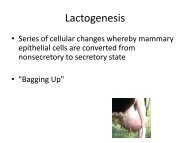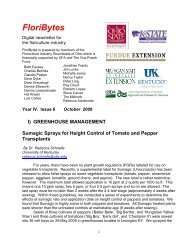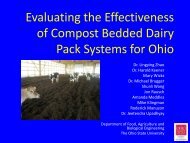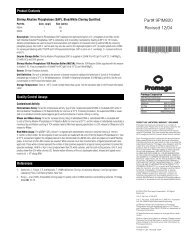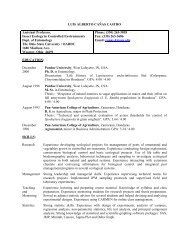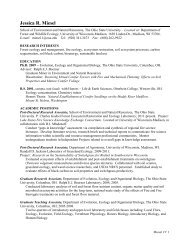GST Fusion Protein Production
GST Fusion Protein Production
GST Fusion Protein Production
Create successful ePaper yourself
Turn your PDF publications into a flip-book with our unique Google optimized e-Paper software.
6. Wash the column with 10 volumes of 1X His-tag binding buffer.<br />
7. Wash the column with 6 volumes of His-tag wash buffer.<br />
Note that if the objective were simply a purification of recombinant protein then the protein could now be<br />
eluted off of the Ni-agarose resin by using 6 volumes of 1X His-tag elution buffer or by cleavage at the<br />
fusion protein junction with the thrombin cleavage protease. However if the objective is to capture other<br />
proteins that “stick” to the rFUSION then the rFUSION should be left attached to the column matrix.<br />
Batch Method (alternative to and much easier than a column)<br />
2. Obtain a sterile 50ml (or 15ml) disposable polypropylene tube.<br />
3. Transfer the required quantity of His•Bind resin to the sterile 50ml (or 15ml) disposable polypropylene<br />
tube. Allow the resin to settle by gravity. Decant off the supernatant. (If working with relatively small<br />
volumes of glutathione agarose and proteins extracts, then it may be easier to perform all of these steps in a<br />
microfuge tube.)<br />
4. Using the same volumes as for the column method above follow the same sequence of washes and<br />
equilibrations to prepare the column (again where 1 volume is equivalent to the settled bed volume). Gently<br />
invert the resin and buffer several times, allow the resin to settle by gravity, decant off the supernatant and<br />
then repeat using the next buffer (if desired the resin may be spun at 500 X g; e.g., ~ setting #1 in a clinical<br />
centrifuge.<br />
(a) 3 volumes of sterile dH 2 0 (to remove EtOH).<br />
(b) 5 volumes of 1X His-tag charge buffer.<br />
(c) 3 volumes of 1X His-tag binding buffer.<br />
5. Add the crude E. coli protein extract to the prepared resin. Gently rock the protein lysate at 4 0 C for ~90<br />
min (e.g., lay the tube on its side on a bed of ice on a shaker). Allow the resin to settle by gravity and then<br />
decant off the supernatant.<br />
6. Add 5X volumes of 1X His-tag binding buffer. Gently rock the protein lysate at 4 0 C for ~5 min. Allow<br />
the resin to settle by gravity and then decant off the supernatant. Repeat with a second 5X volumes of 1X<br />
His-tag binding buffer.<br />
7. Add 3X volumes of 1X His-tag wash buffer. Gently rock the protein lysate at 4 0 C for ~5 min. Allow the<br />
resin to settle by gravity and then decant off the supernatant. Repeat with a second 3X volumes of 1X Histag<br />
binding buffer.<br />
A relatively pure preparation of rHIS-FUSION should now be bound to the Ni-agarose. Verify this by<br />
removing a small aliquot (5-10µL) of the Ni-agarose to which rHIS-FUSION is supposed bound add 1/3<br />
volume SDS loading dye and incubate at 68 o C for 10 minutes. Load this sample onto a protein gel.<br />
Stockinger Lab; Version 02/16/01



